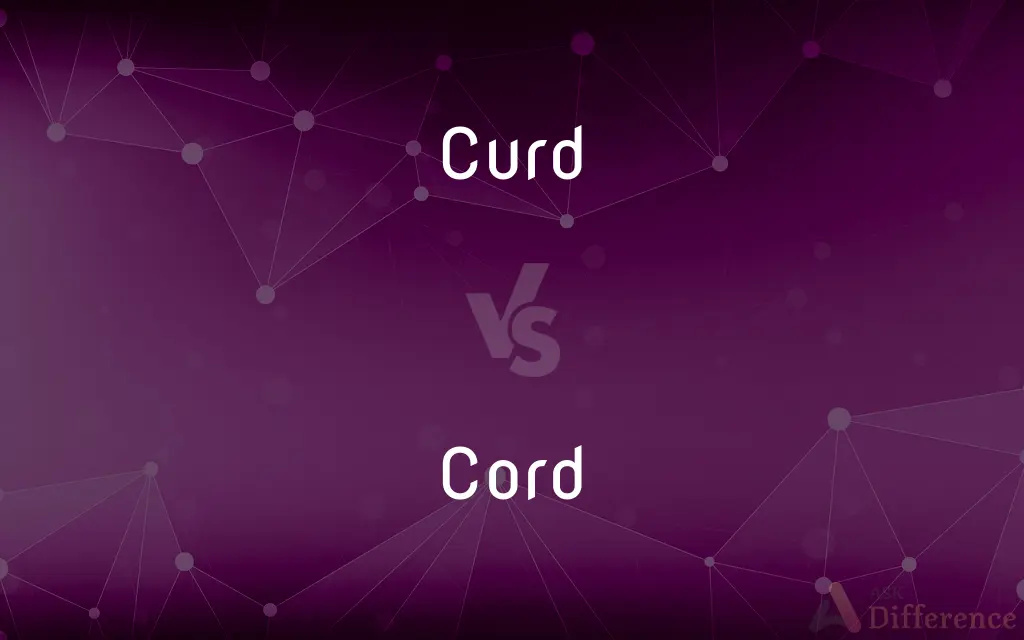Curd vs. Cord — What's the Difference?
By Maham Liaqat & Fiza Rafique — Updated on April 26, 2024
Curd is a dairy product made from coagulated milk, rich in texture and flavor, while cord refers to a length of string or cable, known for its strength and versatility.

Difference Between Curd and Cord
Table of Contents
ADVERTISEMENT
Key Differences
Curd is produced by curdling milk with rennet or edible acidic substances like lemon juice or vinegar, resulting in a soft, edible product. Whereas, cord is typically made from twisting or braiding fibers together to form a longer, stronger line used in various applications from clothing to electrical wiring.
Curd is primarily used in culinary contexts, often eaten directly or as part of dishes like cheesecakes and desserts. On the other hand, cord is utilized in more industrial and functional scenarios such as securing items, in craft, or as part of electronic devices.
Curd's texture can vary from creamy to granular based on its preparation and aging, providing a distinct sensory experience. In contrast, the texture of a cord is generally uniform and designed to be durable under physical stress.
Curd is sensitive to temperature and spoilage, requiring refrigeration and careful handling to maintain its quality and safety. Conversely, cords are designed to withstand environmental factors like temperature changes and rough handling without significant degradation.
Both curd and cord are versatile in their respective fields; curd adapts to various culinary roles from main dishes to condiments, while cord’s versatility extends from household utility to technological uses.
ADVERTISEMENT
Comparison Chart
Definition
A dairy product made by coagulating milk.
A flexible length of twisted or braided fibers.
Use
Culinary, primarily in foods and desserts.
Functional, used in various binding and structural applications.
Texture
Can vary from creamy to granular.
Generally uniform, designed to be durable.
Sensitivity
Sensitive to temperature, can spoil.
Resistant to environmental factors.
Versatility
Used in various dishes and culinary practices.
Used in a wide range of practical applications.
Compare with Definitions
Curd
Sour curd.
Sour curd is often used in baking to add a tangy flavor.
Cord
Power cord.
The laptop’s power cord needs to be replaced due to fraying.
Curd
Fresh curd.
The fresh curd was served with honey and nuts.
Cord
Nylon cord.
The nylon cord was durable enough for outdoor use.
Curd
Curd cheese.
Curd cheese is softer than cottage cheese and has a mild taste.
Cord
Cotton cord.
Cotton cord is commonly used in arts and crafts for its soft texture.
Curd
Curd formation.
The curd formation begins once the milk is heated with the culture.
Cord
Cord strength.
The cord strength is crucial for its use in climbing equipment.
Curd
Curd texture.
The curd texture can greatly affect the final dish’s consistency.
Cord
Elastic cord.
The elastic cord is ideal for making stretchy bracelets.
Curd
Curd is obtained by coagulating milk in a sequential process called curdling. It can be a final dairy product or the first stage in cheesemaking.
Cord
A slender length of flexible material usually made of twisted strands or fibers and used to bind, tie, connect, or support. See Usage Note at chord1.
Curd
The part of milk that coagulates when the milk sours or is treated with enzymes. Curd is used to make cheese.
Cord
An insulated flexible electric wire fitted with a plug or plugs.
Curd
A lump of curd
Cheese curds.
Cord
A hangman's rope.
Curd
A coagulated liquid that resembles milk curd.
Cord
An influence, feeling, or force that binds or restrains; a bond or tie.
Curd
To form or cause to form into curd; curdle.
Cord
Also chord(Anatomy)A long ropelike structure, such as a nerve or tendon
A spinal cord.
Curd
The part of milk that coagulates when it sours or is treated with enzymes; used to make cottage cheese, dahi, etc.
Cord
A raised rib on the surface of cloth.
Curd
The coagulated part of any liquid.
Cord
A fabric or cloth with such ribs.
Curd
The edible flower head of certain brassicaceous plants.
Cord
Cords Pants made of corduroy.
Curd
(intransitive) To form curd; to curdle.
Cord
A unit of quantity for cut fuel wood, equal to a stack measuring 4 × 4 × 8 feet or 128 cubic feet (3.62 cubic meters).
Curd
(transitive) To cause to coagulate or thicken; to cause to congeal; to curdle.
Cord
To fasten or bind with a cord
Corded the stack of old newspapers and placed them in the recycling bin.
Curd
The coagulated or thickened part of milk, as distinguished from the whey, or watery part. It is eaten as food, especially when made into cheese.
Curds and cream, the flower of country fare.
Cord
To furnish with a cord.
Curd
The coagulated part of any liquid.
Cord
To pile (wood) in cords.
Curd
The edible flower head of certain brassicaceous plants, as the broccoli and cauliflower.
Broccoli should be cut while the curd, as the flowering mass is termed, is entire.
Cauliflowers should be cut for use while the head, or curd, is still close and compact.
Cord
A long, thin, flexible length of twisted yarns (strands) of fiber (rope, for example); uncountable such a length of twisted strands considered as a commodity.
The burglar tied up the victim with a cord.
He looped some cord around his fingers.
Curd
To cause to coagulate or thicken; to cause to congeal; to curdle.
Does it curd thy bloodTo say I am thy mother?
Cord
A small flexible electrical conductor composed of wires insulated separately or in bundles and assembled together usually with an outer cover; the electrical cord of a lamp, sweeper (US vacuum cleaner), or other appliance.
Curd
To become coagulated or thickened; to separate into curds and whey
Cord
A unit of measurement for firewood, equal to 128 cubic feet (4 × 4 × 8 feet), composed of logs and/or split logs four feet long and none over eight inches diameter. It is usually seen as a stack four feet high by eight feet long.
Curd
A coagulated liquid resembling milk curd;
Bean curd
Lemon curd
Cord
(figuratively) Any influence by which persons are caught, held, or drawn, as if by a cord.
Curd
Coagulated milk; used to made cheese;
Little Miss Muffet sat on a tuffet eating some curds and whey
Cord
(anatomy) Any structure having the appearance of a cord, especially a tendon or nerve.
Spermatic cord; spinal cord; umbilical cord; vocal cords
Cord
Dated form of chord: musical sense.
Cord
Misspelling of chord: a cross-section measurement of an aircraft wing.
Cord
To furnish with cords
Cord
To tie or fasten with cords
Cord
To flatten a book during binding
Cord
To arrange (wood, etc.) in a pile for measurement by the cord.
Cord
A string, or small rope, composed of several strands twisted together.
Cord
A solid measure, equivalent to 128 cubic feet; a pile of wood, or other coarse material, eight feet long, four feet high, and four feet broad; - originally measured with a cord or line.
Cord
Fig.: Any moral influence by which persons are caught, held, or drawn, as if by a cord; an enticement; as, the cords of the wicked; the cords of sin; the cords of vanity.
The knots that tangle human creeds,The wounding cords that bind and strainThe heart until it bleeds.
Cord
Any structure having the appearance of a cord, esp. a tendon or a nerve. See under Spermatic, Spinal, Umbilical, Vocal.
Cord
See Chord.
Cord
To bind with a cord; to fasten with cords; to connect with cords; to ornament or finish with a cord or cords, as a garment.
Cord
To arrange (wood, etc.) in a pile for measurement by the cord.
Cord
A line made of twisted fibers or threads;
The bundle was tied with a cord
Cord
A unit of amount of wood cut for burning; 128 cubic feet
Cord
A light insulated conductor for household use
Cord
A cut pile fabric with vertical ribs; usually made of cotton
Cord
Stack in cords;
Cord firewood
Cord
Bind or tie with a cord
Common Curiosities
What is the primary use of curd?
Curd is primarily used in culinary applications as a food product.
Can curd be used in cooking?
Yes, curd can be used in various recipes, including sauces and desserts.
How do environmental factors affect cords?
Cords are designed to resist environmental factors like temperature fluctuations and moisture.
What is the difference in texture between curd and cord?
Curd’s texture is variable and edible, while cord is uniformly tough and non-edible.
What materials are cords made from?
Cords can be made from various materials, including nylon, cotton, and synthetic fibers.
Can cords be used for electrical purposes?
Yes, specifically designed power cords are used for transmitting electricity.
How should curd be stored?
Curd should be stored in a refrigerator to maintain its freshness and prevent spoilage.
What are the common uses of cords in households?
Cords are commonly used for tying, hanging, or securing objects.
How is curd made?
Curd is made by coagulating milk with an acid or enzyme.
What are the health benefits of consuming curd?
Curd is rich in calcium and probiotics, which are beneficial for digestive and bone health.
What makes curd different from other dairy products?
Curd is unique due to its coagulation process, which results in a soft, digestible texture.
Is cord flexibility important?
Yes, cord flexibility is important for its practical use in various applications.
Share Your Discovery

Previous Comparison
Endothelium vs. Epithelium
Next Comparison
Yakuza vs. TriadAuthor Spotlight
Written by
Maham LiaqatCo-written by
Fiza RafiqueFiza Rafique is a skilled content writer at AskDifference.com, where she meticulously refines and enhances written pieces. Drawing from her vast editorial expertise, Fiza ensures clarity, accuracy, and precision in every article. Passionate about language, she continually seeks to elevate the quality of content for readers worldwide.
















































